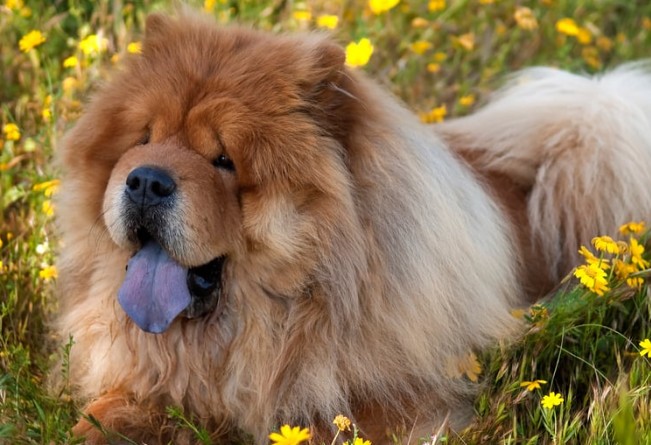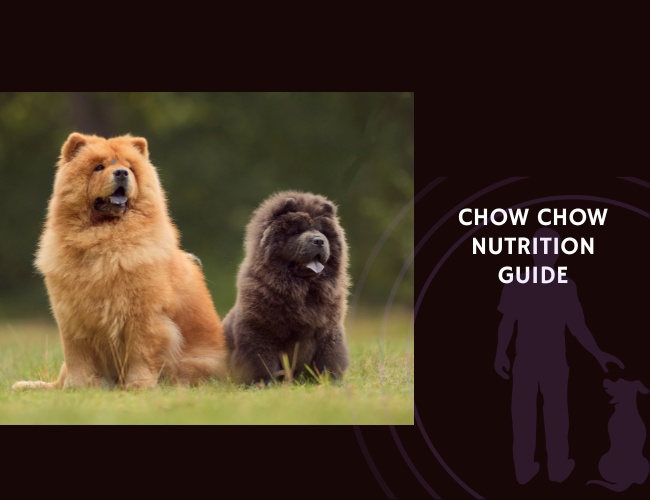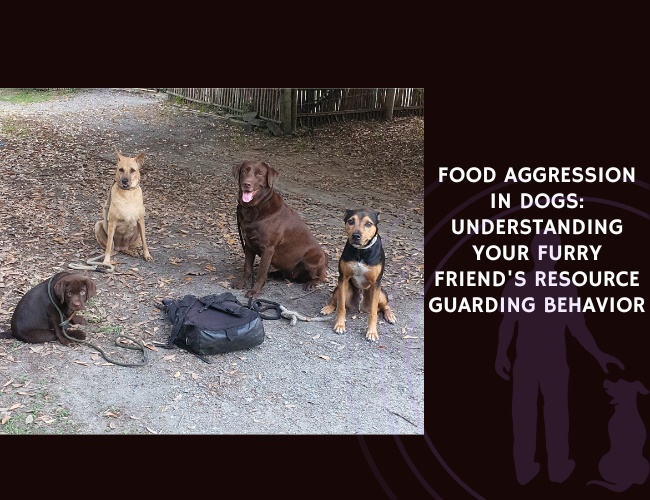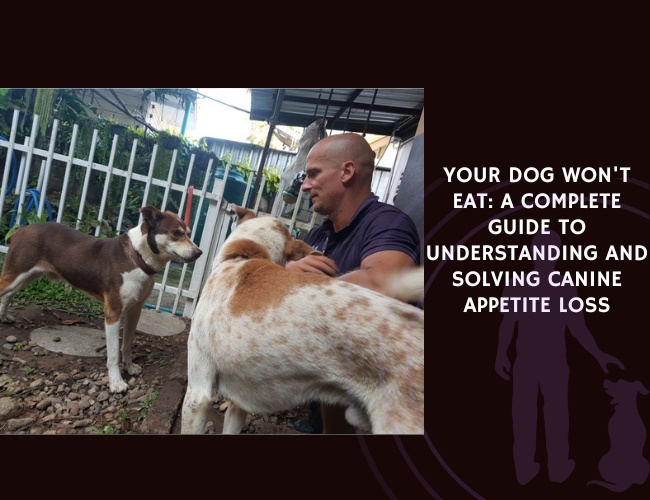Introduction
Chow Chow’s majestic lion-like mane and distinctive blue-black tongue make them one of the most recognizable breeds in the canine world. But beneath that regal exterior lies a unique digestive system with specific nutritional needs that have evolved over thousands of years. Understanding how to properly nourish your Chow Chow isn’t just about filling their bowl—it’s about honoring their ancient heritage while supporting their modern lifestyle.
Did you know that your Chow Chow have one of the most efficient metabolisms among dog breeds? This evolutionary adaptation helped them survive in harsh conditions throughout their history in ancient China. Today, this means your furry friend requires a thoughtfully planned diet that respects their moderate energy needs while preventing the obesity they’re naturally prone to. Let us guide you through everything you need to know about feeding your Chow Chow for optimal health and longevity. 🧡
Character & Metabolism: Understanding Your Chow’s Unique System
The Moderate Metabolizer
Your Chow Chow’s metabolism tells a fascinating story of adaptation. Unlike high-energy breeds that burn through calories rapidly, Chow Chows exhibit a moderate to low metabolic rate—a trait that served them well during their working days in ancient China. This metabolic efficiency means your companion requires fewer calories per pound than you might expect, making portion control essential.
Basal Energy Requirements (BER) for your Chow vary based on several factors:
- Age and life stage
- Activity level (from couch companion to active walker)
- Body Condition Score (BCS)
- Individual metabolic variations
You might notice your Chow seems satisfied with less food than similarly-sized breeds. This isn’t them being picky—it’s their efficient metabolism at work. Adult Chow Chows typically require 20-30 calories per pound of body weight daily, though this can vary significantly based on individual factors.
Digestive Efficiency & Sensitivities
The Chow Chow’s digestive system reflects their ancient heritage as versatile omnivores. While generally considered to have average digestive efficiency, many Chow Chows develop individual sensitivities that caring owners should watch for.
Common digestive traits include:
- Moderate stomach capacity requiring measured portions
- Potential sensitivity to rapid diet changes
- Individual variations in ingredient tolerance
- Tendency toward slower eating patterns
Your Chow’s deep chest creates a predisposition to bloat (gastric dilatation-volvulus), making feeding practices particularly important. Multiple smaller meals throughout the day not only support their metabolism but also reduce this serious health risk. 🐾
Macronutrient Requirements: Building Blocks of Health
Protein: The Foundation of Strength
Protein serves as the cornerstone of your Chow Chow’s nutrition, supporting everything from their luxurious double coat to their sturdy musculature. But here’s where understanding becomes crucial—not all proteins are created equal, and your Chow’s needs change throughout their life.
Life Stage Protein Requirements:
- Puppies (0-12 months): 22-26% of dry matter
- Adults (1-7 years): 18-22% of dry matter
- Seniors (7+ years): 20-24% of dry matter
Why do senior Chows need slightly more protein? As your companion ages, maintaining muscle mass becomes increasingly important. That slight increase helps combat age-related muscle wasting (sarcopenia) while supporting their immune system.
Quality matters more than quantity. Look for named meat sources (chicken, lamb, fish) as primary ingredients. Your Chow’s ancestral diet included varied protein sources, and this diversity can benefit modern dogs too.
Fat: Energy and Essential Nutrients
Fat often gets a bad reputation, but for your Chow Chow, it’s an essential macronutrient providing concentrated energy and vital fatty acids. The key lies in finding the right balance—enough to support their skin and coat health without contributing to weight gain.
Optimal Fat Levels:
- Adult maintenance: 15-20% of dry matter
- Puppies: 18-22% of dry matter
- Less active seniors: 12-15% of dry matter
The fatty acid profile matters tremendously. Your Chow’s magnificent coat benefits from a balanced ratio of Omega-3 to Omega-6 fatty acids, ideally around 1:4. Sources like fish oil, flaxseed, and chicken fat provide these essential nutrients.
Did you know that proper fat intake can reduce your Chow’s tendency toward dry, flaky skin? Many owners notice dramatic improvements in coat quality when fatty acid balance is optimized.
Carbohydrates: The Balanced Approach
Carbohydrates remain perhaps the most debated macronutrient in canine nutrition. For your Chow Chow, the answer isn’t elimination but rather thoughtful selection and moderation. Their efficient metabolism means excessive carbohydrates quickly convert to stored fat.
Carbohydrate Guidelines:
- Moderate levels: 30-40% of dry matter
- Focus on digestible sources (sweet potato, brown rice, oats)
- Avoid excessive simple sugars
- Consider grain-free only if sensitivity exists
Your Chow’s individual tolerance varies. Some thrive on moderate whole grain inclusion, while others show improved energy and coat condition on lower carbohydrate formulas. Observing your dog’s response guides these decisions.
Micronutrient Profile: The Hidden Heroes
Essential Vitamins
While macronutrients provide the building blocks, vitamins orchestrate countless biochemical processes keeping your Chow Chow healthy. Each vitamin plays specific roles, and deficiencies can manifest in subtle ways before becoming obvious problems.
Critical Vitamins for Chow Chows:
Vitamin A supports your Chow’s vision and immune function. You might notice improved tear staining and clearer eyes with adequate levels. Natural sources include liver, carrots, and sweet potatoes.
Vitamin D works hand-in-hand with calcium for bone health. Chow Chows’ dense bone structure requires consistent vitamin D intake, especially for indoor dogs with limited sun exposure.
Vitamin E acts as a powerful antioxidant, particularly important for your Chow’s skin health. This fat-soluble vitamin helps combat the oxidative stress that can lead to premature aging.
B-Complex Vitamins support energy metabolism and neurological function. These water-soluble vitamins require daily replenishment, making consistent dietary sources essential.
Mineral Balance
Minerals work in delicate balance within your Chow Chow’s body. Too much or too little of any single mineral can disrupt this harmony, leading to health issues that may take months to manifest.
The calcium-phosphorus ratio proves particularly critical for Chow Chows. Their predisposition to hip dysplasia means maintaining a proper 1.2:1 ratio supports optimal bone development and maintenance. Puppies require special attention—excess calcium during growth can actually increase dysplasia risk.
Zinc deserves special mention for Chow Chows. This mineral supports immune function and skin health, addressing two areas where the breed can show vulnerabilities. Signs of zinc deficiency include dull coat, slow wound healing, and increased infections.
Selenium works synergistically with Vitamin E as an antioxidant. Given Chow Chows’ tendency toward certain cancers as they age, maintaining optimal selenium levels provides protective benefits.
Trace Elements & Balance
The trace element profile in your Chow’s diet often goes overlooked, yet these micronutrients influence everything from enzyme function to hormone production. Iron, copper, manganese, and iodine all play vital roles in maintaining your companion’s health.
Regular blood work helps identify any imbalances before clinical signs appear. This proactive approach particularly benefits Chow Chows, who may not show obvious distress until problems become advanced—a trait linked to their stoic temperament.

Common Food Sensitivities: Recognizing the Signs
Identifying Allergies vs. Intolerances
Your Chow Chow’s dignified demeanor might mask discomfort from food sensitivities, making vigilant observation essential. Understanding the difference between true allergies (immune-mediated responses) and intolerances (digestive issues) helps guide appropriate dietary adjustments.
Common allergens affecting Chow Chows:
- Beef (most common protein allergen)
- Chicken
- Dairy products
- Wheat
- Soy
- Corn
Clinical signs to monitor:
- Persistent scratching or licking
- Red, inflamed skin (particularly ears and paws)
- Recurring ear infections
- Gastrointestinal upset (vomiting, diarrhea)
- Excessive tear staining
- Changes in stool consistency
The Elimination Diet Approach
When sensitivities are suspected, an elimination diet provides the gold standard for identification. This systematic approach requires patience but yields definitive results.
Start with a novel protein and carbohydrate source your Chow has never eaten. Feed exclusively for 8-12 weeks, then gradually reintroduce suspected allergens one at a time. Document any reactions carefully—your observations become invaluable diagnostic tools.
Remember, food sensitivities can develop at any life stage. That chicken-based diet your Chow thrived on for years might suddenly become problematic. Stay alert to changes in your companion’s condition.
Life Stage Nutrition: Tailoring Diet Through the Years
Puppy Nutrition (0-12 Months)
Your Chow Chow puppy’s nutrition during their first year lays the foundation for lifelong health. This critical period demands careful attention to support proper growth without encouraging the too-rapid development that can stress developing joints.
Growth Stage Considerations:
- 0-3 months: Mother’s milk or high-quality puppy milk replacer
- 3-6 months: Transition to solid food, 3-4 meals daily
- 6-12 months: Gradual reduction to 2-3 meals daily
Chow Chow puppies grow more slowly than many breeds, reaching full size around 12-18 months. This extended growth period means maintaining puppy-formulated nutrition longer than you might expect. Resist the urge to accelerate growth through overfeeding—your patience protects their joint health.
Critical nutrients during growth:
- DHA for brain development
- Controlled calcium levels (1.2-1.5% dry matter)
- High-quality protein for muscle development
- Adequate calories without excess
Adult Maintenance (1-7 Years)
The adult years represent your Chow Chow’s prime, where proper nutrition maintains their health and prevents future problems. This stage requires balancing their efficient metabolism with their tendency toward weight gain.
Adult Feeding Strategies:
- Consistent meal times (twice daily works well)
- Measured portions based on body condition
- Regular weight monitoring
- Seasonal adjustments for activity changes
Your adult Chow’s nutritional needs remain relatively stable, but individual variations matter. The couch-loving Chow requires fewer calories than their more active counterpart. Use body condition scoring rather than scale weight alone—muscle mass and body composition tell the complete story.
Senior Support (7+ Years)
As your Chow Chow enters their golden years, nutritional adjustments can significantly impact quality of life. Senior dogs aren’t just older adults—they have distinct nutritional needs requiring thoughtful modification.
Senior Nutritional Priorities:
- Increased protein (20-24%) to maintain muscle mass
- Joint support (glucosamine, chondroitin, omega-3s)
- Antioxidants for cognitive function
- Controlled phosphorus for kidney health
- Enhanced digestibility
You might notice your senior Chow becomes pickier about food. This isn’t mere stubbornness—aging can affect taste and smell perception. Warming food slightly or adding low-sodium broth can restore appetite while ensuring adequate nutrition.
Reproductive Nutrition
For breeding Chow Chows, nutrition becomes even more critical. Pregnant and lactating females have dramatically increased nutritional demands that standard maintenance diets cannot meet.
- Weeks 1-4: Maintain normal diet
- Weeks 5-6: Increase food by 25-30%
- Weeks 7-9: Increase food by 50%, feed 3-4 times daily
Lactation places the highest nutritional demands on your Chow. Energy requirements can triple during peak lactation. Free-choice feeding of high-quality puppy food often works best during this intensive period.
Regal. Rooted. Refined.
Your Chow’s diet is a tribute to ancient design.
Beneath the lion-like coat lies a metabolism shaped by survival, not indulgence. Feeding a Chow isn’t about trend—it’s about matching their stoic, efficient system with a steady, species-appropriate foundation.
Precision replaces assumption in every bowl.
From calorie limits to fat ratios, this breed thrives not on abundance but on balance. Overfeeding invites risk; underfeeding weakens resilience. Every nutrient must serve a purpose—or it doesn’t belong.



True care means feeding with eyes open.
Each stage, each symptom, each subtle change tells you how your Chow is coping. When you nourish with intention, guided by both heritage and science, you don’t just extend life—you elevate it.
Managing Breed-Specific Health Risks Through Nutrition
Hip Dysplasia: The Nutritional Connection
Hip dysplasia affects many Chow Chows, but nutrition plays a powerful preventive role. While genetics set the stage, environmental factors—particularly nutrition—influence whether this predisposition manifests as clinical disease.
Nutritional strategies for hip health:
- Maintain ideal body weight (every extra pound stresses joints)
- Ensure proper calcium-phosphorus balance
- Include joint-supporting nutrients (glucosamine, MSM)
- Consider omega-3 supplementation for anti-inflammatory effects
The connection between puppy nutrition and adult hip health cannot be overstated. Overfeeding during growth, particularly with excessive calcium, increases dysplasia risk. Follow feeding guidelines carefully, resisting those pleading eyes asking for extra portions.
Bloat Prevention Through Feeding Practices
Gastric dilatation-volvulus (bloat) represents a life-threatening emergency for deep-chested breeds like Chow Chows. While surgical prevention exists, dietary management significantly reduces risk.
Bloat prevention strategies:
- Feed 2-3 smaller meals rather than one large meal
- Avoid exercise 1 hour before and after eating
- Use elevated feeders cautiously (research remains conflicting)
- Prevent rapid eating with slow-feed bowls
- Limit water intake immediately after meals
- Avoid foods that increase gas production
Creating calm mealtimes matters too. Stress during eating increases air swallowing, a bloat risk factor. Feed your Chow in a quiet location away from competition or disruption.
Pancreatitis & Fat Management
Chow Chows’ efficient metabolism makes them susceptible to pancreatitis when exposed to high-fat foods. This painful inflammation of the pancreas can become chronic without proper management.
Preventing pancreatitis:
- Maintain consistent fat levels (avoid table scraps)
- Choose moderate-fat diets (15-20% for healthy adults)
- Transition foods gradually
- Monitor for early signs (vomiting, abdominal pain, lethargy)
For Chows with pancreatitis history, prescription low-fat diets may become necessary. Work closely with your veterinarian to balance fat restriction with adequate nutrition.
Heart Health & Taurine
Recent research has highlighted connections between diet and dilated cardiomyopathy (DCM) in dogs. While Chow Chows aren’t considered a high-risk breed, maintaining adequate taurine levels supports cardiac health.
Supporting heart health:
- Ensure adequate taurine through meat-based proteins
- Consider taurine supplementation for grain-free diets
- Include omega-3 fatty acids for cardiovascular support
- Monitor for early cardiac signs (exercise intolerance, coughing)
Regular veterinary checkups become increasingly important as your Chow ages, allowing early detection of cardiac issues where nutritional intervention can make the greatest impact.
Feeding Methods & Diet Types: Finding Your Path
Commercial Kibble: The Convenient Choice
Kibble remains the most popular feeding choice for good reason—convenience, shelf stability, and complete nutrition in every bite. But not all kibbles are created equal, particularly for your discerning Chow Chow.
Selecting quality kibble:
- Named meat as first ingredient
- Appropriate protein levels for life stage
- Limited fillers and by-products
- AAFCO certification for complete nutrition
- Appropriate kibble size for your Chow’s mouth
Your Chow’s unique mouth structure, with their shorter muzzle, may influence kibble preference. Some do better with larger kibbles that encourage chewing, while others prefer smaller pieces. Experiment to find what works best.
Raw Feeding: Back to Nature?
The raw feeding movement has gained passionate advocates, and some Chow Chows thrive on carefully balanced raw diets. This approach requires commitment and education but can yield impressive results.
Raw feeding considerations:
- Requires careful nutritional balancing
- Food safety protocols essential
- Higher cost than commercial diets
- Time-intensive preparation
- Potential for improved coat and energy
If choosing raw feeding, work with a veterinary nutritionist to ensure complete nutrition. The “prey model” or “BARF” (Biologically Appropriate Raw Food) approaches each have merits, but both require modification for your Chow’s specific needs.
Home-Cooked Diets: The Personal Touch
Preparing home-cooked meals for your Chow Chow offers ultimate control over ingredients while strengthening your bond through food preparation. This approach particularly benefits dogs with multiple sensitivities or specific health conditions.
Home cooking essentials:
- Consult veterinary nutritionist for balanced recipes
- Include variety for complete nutrition
- Supplement appropriately (especially calcium)
- Batch cook for convenience
- Monitor body condition closely
Many Chow Chows appreciate the variety home cooking provides. Their sometimes-finicky appetites often improve with rotating proteins and vegetables, though changes should be gradual to avoid digestive upset.
Combination Approaches
Real life often demands flexibility. Many successful Chow Chow owners combine feeding methods—perhaps kibble for breakfast and home-cooked dinner, or raw meals several times weekly with high-quality kibble between.
This approach provides variety while maintaining nutritional consistency. It also prepares your Chow for dietary flexibility, useful during travel or emergencies.
Practical Feeding Guidelines: Day-to-Day Success
Establishing Mealtime Routines
Your Chow Chow’s independent nature appreciates predictable routines. Consistent meal times not only aid digestion but also provide structure your companion finds comforting.
Creating positive mealtime experiences:
- Feed at consistent times daily
- Choose a quiet, low-traffic location
- Use non-slip bowls at comfortable height
- Allow 20-30 minutes for eating
- Remove uneaten food to prevent grazing
Some Chow Chows exhibit food guarding behaviors—a remnant of their protective instincts. Address this early through positive training, teaching that human approach during meals brings good things (like special treats) rather than threats.
Portion Control & Weight Management
Your Chow’s efficient metabolism means excess weight accumulates easily but comes off slowly. Maintaining ideal body condition requires vigilance and sometimes tough love when those expressive eyes plead for more.
Body Condition Scoring (BCS):
- Score 1-3: Too thin (ribs prominent)
- Score 4-5: Ideal (ribs felt but not seen)
- Score 6-9: Overweight to obese
Weigh your Chow monthly, but rely more on visual and hands-on assessment. Their thick coat can hide weight changes that your hands will detect through regular grooming sessions.
Managing Picky Eating
Some Chow Chows develop reputations as picky eaters, but this often stems from their lower caloric needs rather than true finickiness. Understanding the difference helps address the issue appropriately.
Strategies for picky eaters:
- Rule out medical causes first
- Avoid constantly switching foods
- Limit treats to 10% of daily calories
- Try food puzzles for mental stimulation
- Warm food slightly to enhance aroma
Remember, a healthy Chow won’t starve themselves. If your companion skips an occasional meal but maintains good body condition, this might simply reflect their efficient metabolism at work. 🐾
Supplements: Enhancing the Foundation
While a balanced diet should provide complete nutrition, certain supplements can address breed-specific concerns or individual needs. Always consult your veterinarian before adding supplements, as excess can prove harmful.
Beneficial supplements for Chow Chows:
- Joint support: Glucosamine, chondroitin, MSM
- Omega-3 fatty acids: Fish oil for skin and coat
- Probiotics: Supporting digestive health
- Antioxidants: Vitamin E, selenium for aging dogs
Quality matters with supplements. Choose products with third-party testing and avoid mega-doses that can create imbalances.

Special Considerations: Beyond Basic Nutrition
Exercise & Nutrition Timing
Your Chow Chow’s exercise needs interact closely with their nutritional requirements. These dignified dogs don’t demand intensive exercise, but timing meals around activity prevents problems.
Exercise-nutrition guidelines:
- Wait 1 hour after eating before exercise
- Provide water during activity, but limit large amounts
- Adjust calories based on seasonal activity changes
- Consider post-exercise snacks for very active days
Your Chow’s lower exercise requirements mean calorie needs remain modest. That weekend hike doesn’t necessarily warrant a larger dinner—monitor body condition as your guide.
Environmental Factors
Your Chow Chow’s magnificent double coat provides excellent insulation, but this affects nutritional needs seasonally. Summer’s heat may suppress appetite, while winter might increase caloric requirements slightly.
Seasonal adjustments:
- Increase water availability in summer
- Consider slightly higher calories in winter
- Adjust feeding times to cooler parts of day in summer
- Monitor weight changes with seasonal coat changes
Climate control indoors can minimize these variations, but outdoor Chows show more pronounced seasonal patterns.
Behavioral Considerations
The Chow Chow’s independent temperament influences feeding behaviors in unique ways. Understanding these breed traits helps create successful nutritional strategies.
Your Chow might prefer eating alone, away from other pets or family commotion. This isn’t antisocial behavior—it’s their natural inclination for peaceful dining. Respect these preferences while maintaining household routines.
Food-based training requires special consideration. While many breeds respond enthusiastically to treat training, Chow Chows’ lower food drive means finding individual motivators. Experiment with different rewards—some prefer play or praise over treats.
Monitoring & Adjusting: The Ongoing Journey
Health Indicators
Your Chow Chow may not readily show discomfort, making regular monitoring essential. Nutritional health manifests in multiple ways beyond simple weight.
Signs of optimal nutrition:
- Bright, clear eyes without excessive tearing
- Lustrous, full coat without excessive shedding
- Good energy for breed (calm but alert)
- Formed stools, 1-2 times daily
- Healthy skin without flaking or odor
- Appropriate muscle tone
Document these observations regularly. Changes often occur gradually, and written records help identify trends your memory might miss.
Working with Your Veterinarian
Your veterinarian serves as an essential partner in your Chow’s nutritional journey. Regular checkups provide objective assessment and early problem detection.
Maximizing veterinary visits:
- Bring food labels for review
- Document any concerns between visits
- Request body condition scoring
- Discuss blood work for senior dogs
- Ask about breed-specific concerns
Don’t hesitate to request referral to a veterinary nutritionist for complex cases. Your Chow’s unique needs sometimes benefit from specialized expertise.
Troubleshooting Common Issues
Even with excellent planning, nutritional challenges arise. Understanding common issues helps you respond appropriately.
Sudden appetite loss warrants veterinary attention if lasting over 24 hours. Check for dental issues, a common cause in Chow Chows.
Chronic soft stools might indicate food intolerance or excessive fat. Try eliminating common allergens systematically.
Weight gain despite controlled portions suggests metabolic changes. Thyroid testing may reveal hypothyroidism, not uncommon in the breed.
Excessive water consumption could signal various issues from diabetes to kidney disease. Document intake amounts for veterinary discussion.
The Technology Age: Modern Tools for Nutrition
Apps & Tracking
Modern technology offers powerful tools for managing your Chow Chow’s nutrition. Various apps help track feeding, weight, and body condition over time.
Useful features to seek:
- Calorie calculators based on weight and activity
- Food diary functions
- Weight tracking with graphs
- Reminder systems for feeding times
- Integration with veterinary records
These tools prove particularly valuable for multi-pet households or when multiple family members share feeding responsibilities.
Automatic Feeders & Portion Control
For Chow Chows prone to weight gain, automatic feeders provide consistent portion control. Some models include features particularly useful for the breed.
Beneficial features:
- Slow-feed settings for bloat prevention
- Multiple small meal programming
- Portion control to the gram
- Camera monitoring for remote observation
- App integration for feeding tracking
While technology helps, it doesn’t replace observation. Your Chow’s individual needs might require manual adjustments despite programmed settings.
Conclusion: Your Chow’s Nutritional Journey
Nourishing your Chow Chow properly combines science with art, requiring both knowledge and observation. Their unique metabolism, bred through centuries of adaptation, demands respect through thoughtful feeding practices. From puppyhood’s critical growth through senior years’ special needs, each life stage brings distinct nutritional requirements.
Remember, no single approach works for every Chow Chow. Your companion’s individual needs, influenced by genetics, activity, and health status, guide optimal nutrition choices. Stay observant, work closely with your veterinary team, and remain flexible as needs change.
The effort you invest in understanding and meeting your Chow Chow’s nutritional needs pays dividends through years of companionship with a healthy, content friend. Their dignified presence and loyal heart deserve nothing less than our best efforts in return.
Is your Chow Chow receiving the nutrition they need to thrive? Take time today to evaluate their diet, body condition, and overall health. Small adjustments now can prevent significant problems later, ensuring your lion-maned companion enjoys the quality of life they deserve. After all, proper nutrition isn’t just about feeding—it’s about nurturing the deep bond you share with your magnificent Chow Chow. 🧡










